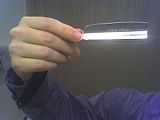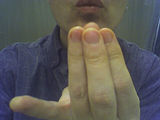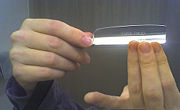Difference between revisions of "Shaving against the grain on the upper lip - The Fool's Pass"
m (Just added stuff from http://en.wikipedia.org/w/index.php?title=Straight_razor <- I think we should be able to populate this page...) |
m (Text replacement - "http://straightrazorpalace.com" to "https://straightrazorpalace.com") |
||
| (23 intermediate revisions by 4 users not shown) | |||
| Line 1: | Line 1: | ||
| − | + | Shaving against the grain on the upper lip is listed as a clear ‘Do Not Do’, but that hasn’t stopped me.<ref>https://straightrazorpalace.com/old_site/inthedeepend/?p=31</ref> After months of trying and trying and failing and failing to get my lip clean, I ventured into the dark waters of an uncertain path that no-one would even speak about let alone recommend. It’s understandable. I’ll bet there used to be old urban legends about the sailor who, while shaving with a hangover (or worse) cuts the tip of his nose off. If he were as swift as one of our member he would simply put it back on and be using it like normal later that day. When I imagine century old sailors I don’t picture them being that sharp. Sailors aside, I was adamant (as I have been since I started straight shaving) that I would NOT hurt myself so I did not proceed until I was certain that I was completely safe. I’ll start with stage one: | |
| − | + | Using the safe heel of the blade and shaving against the grain on either side of my nose permitted me to get the two sides of my upper lip (not directly below my nose) I was able to move the razor well beyond my nose in a safe fashion and get a smooth shave over my whole upper lip except for that trouble spot, the Chaplin spot. By shaving up at an angle from the centre of my lip outward and upward past my nose as described cleaned a wider area, but still left some fuzz behind. I’ve got some seriously stubborn hairs that are very fine and sit flat against my skin. Anything except an against the grain pass will not leave my face clean. It’s that simple. I made do with that for a few weeks until it came to me. I knew how I could be safe getting right up under my nose. | |
| + | |||
| + | == Disclaimer == | ||
| + | |||
| + | Here’s the disclaimer moment: '''Do not try this yourself.''' You heard me, I said ''no''. It is a Fool's Pass and if you are foolhardy enough not to heed my advice, keep something else in mind. Your first objective is ''not'' to get a good shave. Getting a good shave is now your secondary objective. Avoiding ''all'' injury is now your primary goal. It should have been that way all along. If you are foolish enough to follow me into the murky darkness, you are talking a risk! Under no circumstances should you ever point a razor's edge in the direction of your nose. Even a fool knows that. Don't be foolish. | ||
| + | |||
| + | == How it is done == | ||
| + | |||
| + | <gallery caption="The three parts to the preparation" widths="180px" heights="120px" perrow="3"> | ||
| + | Image:ATG Upper Lip 01.jpg | I hold the razor in my dominant hand by the shank and turn the blade upward so it points at the sky. | ||
| + | Image:ATG Upper Lip 02.jpg | Put my first three fingertips (index, middle and ring) of my off hand together with my thumb and point them to the sky. I call this the French Chef Salute. It’s the sort of thing you’ll see a cook do when he kisses his fingertips to indicate a delectable dish. | ||
| + | Image:ATG Upper Lip 03.jpg | Put the spine of the razor on top of my off hand fingertips. | ||
| + | </gallery> | ||
| + | |||
| + | With the razor’s spine pressed gently down onto the off hand, there’s a great deal of control over where the blade is going. It’s almost impossible for me to imagine losing control of the blade. All that’s needed is to ''go slow''. I don’t trouble myself with my secondary objective (good shave) too much. That happens because I happen to be shaving. I make sure that there is no chance of injury. That includes, but is not limited to; | ||
| + | # Keeping balance. I don’t lean against the sink, lock my knees or shorten my lower back. | ||
| + | # Keeping footing. I do not stand on an uneven, wet or otherwise uncertain landscape. | ||
| + | # Always knowing where the edge is and being ready to take it away from my face at all times. | ||
| + | # Using NO pressure. | ||
| + | # Stretching the lip as taut as possible. | ||
| + | # Breathing evenly for maximum relaxation and attention. | ||
| + | I don’t know if all that’s ''no'' chance of injury, but it’s a severely limited chance of injury and I’m comfortable with that. | ||
==Citations and notes== | ==Citations and notes== | ||
| Line 7: | Line 28: | ||
<references /> | <references /> | ||
| − | [[Category: | + | [[Category:Advanced_shaving_techniques]] |
| − | |||
Latest revision as of 10:37, 17 February 2018
Shaving against the grain on the upper lip is listed as a clear ‘Do Not Do’, but that hasn’t stopped me.[1] After months of trying and trying and failing and failing to get my lip clean, I ventured into the dark waters of an uncertain path that no-one would even speak about let alone recommend. It’s understandable. I’ll bet there used to be old urban legends about the sailor who, while shaving with a hangover (or worse) cuts the tip of his nose off. If he were as swift as one of our member he would simply put it back on and be using it like normal later that day. When I imagine century old sailors I don’t picture them being that sharp. Sailors aside, I was adamant (as I have been since I started straight shaving) that I would NOT hurt myself so I did not proceed until I was certain that I was completely safe. I’ll start with stage one:
Using the safe heel of the blade and shaving against the grain on either side of my nose permitted me to get the two sides of my upper lip (not directly below my nose) I was able to move the razor well beyond my nose in a safe fashion and get a smooth shave over my whole upper lip except for that trouble spot, the Chaplin spot. By shaving up at an angle from the centre of my lip outward and upward past my nose as described cleaned a wider area, but still left some fuzz behind. I’ve got some seriously stubborn hairs that are very fine and sit flat against my skin. Anything except an against the grain pass will not leave my face clean. It’s that simple. I made do with that for a few weeks until it came to me. I knew how I could be safe getting right up under my nose.
Disclaimer[edit | edit source]
Here’s the disclaimer moment: Do not try this yourself. You heard me, I said no. It is a Fool's Pass and if you are foolhardy enough not to heed my advice, keep something else in mind. Your first objective is not to get a good shave. Getting a good shave is now your secondary objective. Avoiding all injury is now your primary goal. It should have been that way all along. If you are foolish enough to follow me into the murky darkness, you are talking a risk! Under no circumstances should you ever point a razor's edge in the direction of your nose. Even a fool knows that. Don't be foolish.
How it is done[edit | edit source]
- The three parts to the preparation
With the razor’s spine pressed gently down onto the off hand, there’s a great deal of control over where the blade is going. It’s almost impossible for me to imagine losing control of the blade. All that’s needed is to go slow. I don’t trouble myself with my secondary objective (good shave) too much. That happens because I happen to be shaving. I make sure that there is no chance of injury. That includes, but is not limited to;
- Keeping balance. I don’t lean against the sink, lock my knees or shorten my lower back.
- Keeping footing. I do not stand on an uneven, wet or otherwise uncertain landscape.
- Always knowing where the edge is and being ready to take it away from my face at all times.
- Using NO pressure.
- Stretching the lip as taut as possible.
- Breathing evenly for maximum relaxation and attention.
I don’t know if all that’s no chance of injury, but it’s a severely limited chance of injury and I’m comfortable with that.


